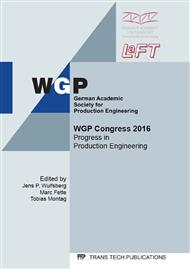[1]
T. Schrader, M. Shirgaokar, T. Altan, A critical evaluation of the double cup extrusion test for selection of cold forging lubricants, J. Mater. Process. Tech. 189 (2007) 36-44.
DOI: 10.1016/j.jmatprotec.2006.11.229
Google Scholar
[2]
X. Tan, P.A. F Martins, N. Bay, W. Zhang, Friction studies at different normal pressures with alternative ring-compression tests, J. Mater. Process. Tech. 80-81 (1998) 292-297.
DOI: 10.1016/s0924-0136(98)00113-7
Google Scholar
[3]
GCFG Doc. 18. 1, Industrielle Untersuchungen zur Umsetzbarkeit der Studie Einfluss der Perliteinformung auf die Fließspannung und das Umformvermögen von C-Stählen, final report IFU, Freiberg (2014).
Google Scholar
[4]
H.F. Boyer, Atlas of stress – strain curves, ASM International, Metals Park, Ohio, (1987).
Google Scholar
[5]
B. Zimmermann, M. Merklein, Einfluss der Umformhistorie eines Drahtwerkstoffes auf die mehrstufige Umformung eines Schraubenrohlings, Tagungsband 16. RoundTable Simulating Manufacturing, Marburg (2015).
Google Scholar
[6]
R. Geiger, Der Stofffluss beim kombinierten Napffließpressen, Berichte aus dem Instiut für Umformtechnik 36, K. Lange, W. Giradet, Essen, (1976).
Google Scholar
[7]
A. Buschhausen, K. Weinmann, J. Y. Lee, T. Altan, Evaluation of Lubrication and friction in cold forging using a double backward-extrusion process, J. Mater. Process. Tech. 33 (1992) 95-108.
DOI: 10.1016/0924-0136(92)90313-h
Google Scholar
[8]
ICFG Doc. 6/82, General recommendations for design, manufacture and operational aspects of cold extrusion tools for steel components, International Cold Forging Group ICFG, Objectives, History, Published Documents, Meisenbach 1992, Bamberg (1967-1982), pp.73-82.
Google Scholar
[9]
H. Sofuoglu, H. Gedikli, Determination of friction coefficient encountered in large deformation processes, Tribology International 35 (2002) 27-34.
DOI: 10.1016/s0301-679x(01)00076-7
Google Scholar
[10]
N.T. Rudkins, P. Hartley, I. Pillinger, D. Petty, Friction modelling and experimental observations in hot ring compression tests, J. Mater. Process. Tech. 60 (1996) 349-353.
DOI: 10.1016/0924-0136(96)02353-9
Google Scholar
[11]
Q. Zhang, E. Felder, S. Bruschi, Evaluation of friction condition in cold forging by using T-shape compression test, J. Mater. Process. Tech. 209 (2009) 5720-5729.
DOI: 10.1016/j.jmatprotec.2009.06.002
Google Scholar
[12]
M. Taureza, S. Castagne, Y. Aue-u-lan, S. Chao Voon Lim, The influence of die geometry and workpiece mechanical properties in T-Shape friction test, J. Mater. Process. Tech. 212 (2012) 2413-2423.
DOI: 10.1016/j.jmatprotec.2012.06.021
Google Scholar
[13]
M. Austen, A. Klonczynski, M. -J. Derenthal, J. Noneder, M. Merklein, Untersuchungen hinsichtlich der Eignung von EN AW 1050 für die Herstellung prismatischer Bauteile mittels Napf-Rückwärts-Fließpressen, EN AW 1050 für Napf-Rückwärts-Fließpressen, Meisenbach GmbH Verlag, Bamberg (2013).
DOI: 10.1007/978-3-642-81712-0_4
Google Scholar


